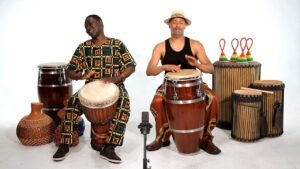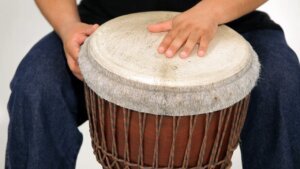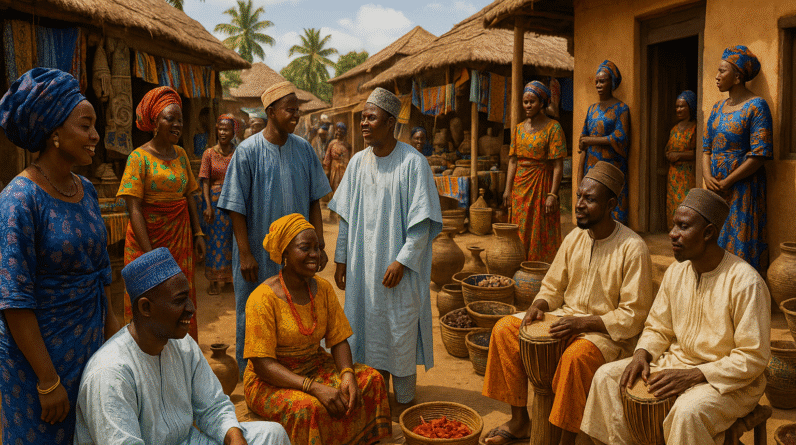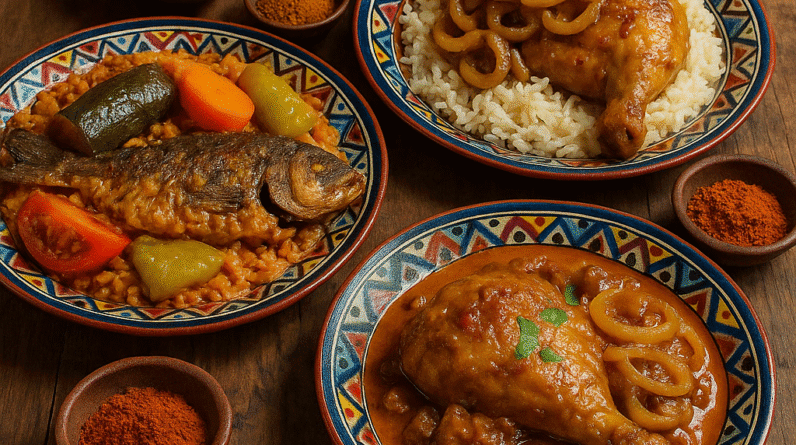
What Is The Significance Of Djembe Drums In African Culture?
What Is The Significance Of Djembe Drums In African Culture? Have you ever wondered about the significance of djembe drums in African culture? These incredible instruments hold a deep meaning and play a vital role in various aspects of African society. From traditional ceremonies to community gatherings, the djembe drums serve as a powerful symbol of unity, communication, and celebration amongst different tribes and communities across the continent. In this article, we will explore the rich history, cultural importance, and captivating sounds of the djembe drums that continue to resonate throughout Africa to this day.
History of Djembe Drums
Origins in West Africa
The history of Djembe drums can be traced back to West Africa, specifically to the Mande people who inhabit parts of present-day Mali, Guinea, Burkina Faso, and Ivory Coast. It is believed that the Djembe drum originated from the Mali Empire, which was one of the largest and most influential empires in Africa during the 12th to 16th centuries. The word “Djembe” itself comes from the Malinke language, meaning “together in peace.”
Role in Traditional African Music
Djembe drums hold a significant role in traditional African music. Used in various ceremonies, celebrations, and spiritual rituals, these drums have been an integral part of the cultural heritage of West African communities for centuries. The rhythmic beats of the Djembe serve as a means of communication, enabling different tribes and villages to convey messages, announce events, and bring people together in harmony.

Spread to Other Regions
Over time, the popularity of Djembe drums spread beyond West Africa, reaching other regions of the continent. With the transatlantic slave trade, Djembe drums made their way to the Americas, specifically to countries like Haiti, Cuba, and Brazil, where they greatly influenced the development of Afro-Caribbean and Afro-Latin music. In recent decades, the Djembe drum has gained global recognition and is now widely played and appreciated in various parts of the world.
Construction and Materials
Traditional Building Techniques
The construction of a traditional Djembe drum involves a meticulous process that has been passed down through generations. The body of the drum is carved from a single piece of hardwood, usually from the Lenke or Djala tree, known for its exceptional tonal qualities. The drumhead, also known as the skin, is traditionally made from goat or antelope hide, stretched tightly over the body of the drum.
Key Components of Djembe
The Djembe drum consists of three main parts – the body, the skin, and the ropes. The body, usually shaped like an hourglass, provides the resonance and tone of the drum. The skin, when properly tensioned, produces different sounds when struck. The ropes, made from natural fibers, are used to secure the skin to the body and allow for tuning.
Choice of Materials
In addition to the choice of hardwood for the body and animal hide for the drumhead, other materials like iron rings and wooden dowels are used in the construction of Djembe drums. These materials are carefully selected for their durability and their ability to enhance the sound quality of the drum. Traditional craftsmen take great pride in sourcing and using high-quality materials to create these instruments.
Symbolism and Cultural Significance
Connection to Ancestors and Spirits
In African culture, Djembe drums hold deep spiritual significance. They are believed to establish a connection between the living and the ancestors, acting as a channel for communication with the spirit world. The rhythmic vibrations of the drums are seen as a means to invoke the presence of ancestors during ceremonies and rituals, allowing their wisdom and guidance to be shared with the community.
Ritual and Ceremonial Use
Djembe drums play an integral role in various rituals and ceremonies within African communities. From birth ceremonies to initiation rites, weddings to funerals, the beats of the Djembe drum set the ambiance and guide the proceedings. These drums are seen as sacred instruments capable of transforming the energy of a space and invoking powerful emotions within participants.
Symbol of Unity and Communication
The Djembe drum serves as a symbol of unity in African culture. When communities come together to play and listen to the drumming, a sense of collective identity and purpose is fostered. Through the beats and rhythms, the Djembe drum facilitates communication, allowing for the sharing of stories, history, and knowledge. It is not only a musical instrument but also a tool for social cohesion and cultural preservation.

Importance in Community Life
Dancing and Celebrations
Djembe drums are an essential part of African dance and celebration. The energetic and vibrant rhythms produced by the drumming serve as the heartbeat of the dance, guiding the movements of the participants. Whether it’s a traditional dance performed at a cultural festival or a community gathering to celebrate a milestone, the Djembe drum’s lively beats create an immersive and invigorating atmosphere, encouraging everyone to join in the revelry.
Storytelling and Folklore
Storytelling and folklore are deeply rooted in African culture, and Djembe drums often accompany such narratives. The rhythm of the drums complements the oral tradition, enhancing the emotional impact of the stories being shared. The beats of the drum help evoke a vivid atmosphere, capturing the attention of the listeners and bringing the tales to life.
Community Bonding and Social Identity
Djembe drums play a vital role in fostering community bonding and social identity. They are frequently used during community gatherings, where people come together to celebrate, discuss important matters, or simply connect with one another. The shared experience of drumming and dancing creates a sense of belonging and strengthens the social fabric of the community.
Role of Djembe Drummers
Tradition of Drumming Mastery
Becoming a Djembe drummer is a lifelong journey, deeply rooted in tradition. It requires years of practice, dedication, and mentorship from experienced drumming masters. In African communities, the title of “drumming master” is highly esteemed and holds great respect. These masters pass down their knowledge and expertise through oral transmission, ensuring the preservation of the drumming traditions for future generations.
Oral Transmission of Knowledge
Unlike formal musical training, the mastery of Djembe drumming is primarily transmitted through oral tradition. Younger generations learn by observing, imitating, and receiving guidance from experienced drummers. This approach fosters a strong sense of community and interpersonal connection, as the knowledge and skills are shared within the social fabric of the culture.
Respect for Drumming Masters
Drumming masters are held in high regard within the African community. Their expertise and command over the Djembe drum are revered, as they are seen as the custodians of tradition and guardians of cultural integrity. Aspiring drummers often seek their guidance and mentorship, showing a deep respect for their wisdom and skill.
Djembe Drumming Techniques
Basics of Playing the Djembe
Playing the Djembe involves a combination of hand techniques and different striking points on the drumhead. The three basic tones produced are the bass, tone, and slap. The bass tone is created by striking the center of the drumhead with a flat hand, resulting in a deep, resonant sound. The tone, produced by striking the edge of the drumhead with the fingers, creates a mid-range sound. Lastly, the slap, achieved by hitting the drumhead with the fingertips, produces a sharp, high-pitched sound.
Different Tones and Sounds
Skilled Djembe drummers can produce a wide range of tones and sounds, allowing for expressive and dynamic performances. By adjusting the striking points, speed, and intensity, drummers can create various combinations of bass, tone, and slap sounds, adding complexity and versatility to their rhythms.
Rhythmic Patterns and Improvisation
Djembe drumming is known for its intricate rhythmic patterns. Through a combination of repetitive patterns and syncopation, drummers create complex and vibrant rhythms that invite dancing and evoke emotional responses. While traditional rhythms are often passed down through generations, Djembe drummers also have the freedom to improvise and add their own personal flair, showcasing their creativity and individuality.
Influence on World Music
Integration into Global Music
The Djembe drum has had a profound influence on world music, particularly through its integration into various genres. From jazz to rock, reggae to electronic music, the rhythmic elements and vibrant sound of the Djembe have found their way into contemporary musical compositions, adding an authentic African flavor and captivating audiences worldwide.
Collaboration and Fusion with Other Genres
The versatility of the Djembe drum allows it to seamlessly collaborate and fuse with other musical genres. In recent years, many artists and musicians have embraced the Djembe as a powerful instrument of cultural exchange and innovation. By combining the traditional rhythms and techniques with modern musical styles, new sounds and possibilities have emerged, creating unique musical experiences and bridging the gap between different cultural traditions.
Popularization and Commercialization
The popularity of Djembe drums has grown significantly in the past few decades. They can now be found in music stores around the world, and many enthusiasts have embraced the instrument, learning to play and appreciate its unique qualities. However, this commercialization has also raised concerns about the authenticity and cultural integrity of Djembe drumming, emphasizing the need for responsible representation and acknowledgment of its African roots.
Preservation and Revival Efforts
Threats to Traditional Drumming
Traditional Djembe drumming faces several threats in today’s modern world. With the rapid pace of urbanization and globalization, younger generations are often drawn towards modern forms of entertainment, resulting in a decline in interest and participation in traditional drumming. Additionally, the availability of inexpensive, mass-produced drums has led to a decrease in demand for authentic, handcrafted Djembes, posing a threat to the livelihood of traditional craftsmen.
Efforts to Safeguard Djembe Culture
Recognizing the importance of preserving Djembe culture, various organizations and individuals are working towards safeguarding its traditions. Initiatives include cultural exchange programs, festivals, and workshops aimed at educating and exposing people to the art of Djembe drumming. By creating platforms for learning, performance, and appreciation, these efforts contribute to the continued vitality and sustainability of Djembe culture.
Teaching and Education Programs
Teaching and education programs play a crucial role in ensuring the continuity of Djembe drumming traditions. Experienced drummers, often referred to as “djembefolas,” offer lessons, workshops, and apprenticeships to aspiring drummers. These programs promote the transfer of knowledge and provide a platform for new generations to learn the intricacies of Djembe drumming, keeping the tradition alive and thriving.
Controversies and Appropriation
Misrepresentation and Exploitation
The rising popularity of Djembe drums has unfortunately led to instances of misrepresentation and exploitation. In some cases, the traditional cultural significance and symbolism of Djembe drumming are diluted or misrepresented to cater to commercial interests, leading to cultural appropriation and a loss of authenticity. It is crucial to respect and honor the cultural roots of the Djembe, ensuring that its traditions are accurately represented and understood.
Respecting Cultural Integrity
Respecting the cultural integrity of Djembe drumming involves acknowledging its historical, spiritual, and social significance. It means approaching the art form with humility and deep respect for the African communities from which it originates. By seeking guidance from experienced practitioners, supporting traditional craftsmen, and engaging in responsible cultural exchange, individuals can contribute to the preservation and authenticity of Djembe culture.
Ethical Considerations
As Djembe drumming continues to gain global recognition, it is important to consider the ethical implications of its appropriation. It is crucial to ensure that African communities are appropriately credited, compensated, and involved in the commercialization of Djembe drums. By fostering fair trade practices, supporting community-led initiatives, and making informed choices as consumers, individuals can promote ethical engagement with Djembe culture.
FAQs: What Is The Significance Of Djembe Drums In African Culture?
1. What is the history behind the djembe drum in African culture?
The djembe drum holds a rich and storied history within African culture, dating back centuries to the ancient empires of Mali and Guinea. Originating among the Mandinka and Malinke peoples of West Africa, the djembe was traditionally crafted from carved wood and animal skins, serving as a sacred instrument deeply intertwined with cultural and spiritual practices. Its rhythmic beats echoed across the savannah, accompanying rites of passage, celebrations, and communal gatherings.
2. How are djembe drums traditionally made?
Traditionally, djembe drums are meticulously crafted by skilled artisans using locally sourced materials. The process begins with selecting the perfect tree, often a hardwood such as lenke or djala, revered for its durability and resonance. The trunk is then carefully carved and hollowed out to create the drum’s shell, while the skin of goats or antelopes is stretched taut over the top and secured with intricate rope tuning systems. Each drum is a unique work of art, reflecting the craftsmanship and cultural heritage of its creator.
3. What role do djembe drums play in African ceremonies and rituals?
Djembe drums hold a central role in African ceremonies and rituals, serving as a powerful medium for spiritual expression and cultural preservation. From birth celebrations to ancestral ceremonies, weddings to funerals, the rhythmic heartbeat of the djembe resonates through the fabric of African life, connecting individuals to their heritage and community. Drumming circles often accompany traditional dances, prayers, and chants, invoking ancestral spirits and fostering collective unity.
4. How do djembe drums contribute to African storytelling and communication?
Djembe drums serve as dynamic tools of storytelling and communication in African oral traditions, conveying narratives, emotions, and historical accounts through rhythm and melody. Drummers communicate with one another and their audience through a complex language of tones, accents, and patterns, transmitting messages across vast distances and generations. Whether recounting epic tales of bravery or expressing the joys and sorrows of everyday life, the djembe embodies the essence of African storytelling.
5. What significance do different parts of the djembe drum hold in African culture?
Each part of the djembe drum holds profound significance in African culture, representing elements of nature, spirituality, and community. The drum’s body symbolizes the earth, its skin the sky, and its sound the heartbeat of the universe. The tuning ropes, known as djeli, connect the drum to ancestral lineage, while the striking surface, or head, embodies the essence of life itself. Together, these components form a sacred vessel through which the spirit of Africa is channeled.
6. How are djembe drums used in traditional African music and dance?
In traditional African music and dance, djembe drums provide the rhythmic foundation upon which intricate melodies and movements are built. From high-energy celebrations to soulful ceremonies, the pulsating rhythms of the djembe drive dancers and musicians alike, inspiring creativity and expression. Each drumbeat tells a story, guiding dancers through a journey of emotion and movement, while inviting participants to connect with their inner rhythms and ancestral roots.
7. What cultural values and traditions are associated with playing the djembe drum?
Playing the djembe drum is steeped in cultural values and traditions that emphasize unity, cooperation, and respect for elders. In many African societies, drummers hold revered positions within the community, serving as both entertainers and mediators. The act of drumming fosters discipline, focus, and camaraderie, instilling a sense of belonging and pride in participants. Additionally, drumming circles often serve as spaces for mentoring and passing down ancestral knowledge to future generations.
8. How have djembe drums evolved and adapted over time within African culture?
Throughout history, djembe drums have evolved and adapted to reflect changing social, cultural, and environmental contexts within African society. Innovations in drum-making techniques, such as the introduction of metal rings for tuning, have enhanced the durability and versatility of the djembe, while expanding its musical capabilities. Additionally, the globalization of African music has led to cross-cultural collaborations and the incorporation of modern elements into traditional drumming practices.
9. What is the symbolism of the djembe drum in African societies?
The djembe drum holds deep symbolic meaning in African societies, representing unity, resilience, and the interconnectedness of all living beings. Its cylindrical shape mirrors the cycle of life and death, while its rhythmic heartbeat evokes the spirit of the ancestors. Playing the djembe is seen as a sacred act that transcends individual identity, connecting drummers to their cultural heritage and the collective soul of Africa.
10. How do djembe drums foster community and social cohesion in African culture?
Djembe drums serve as powerful catalysts for community building and social cohesion in African culture, bringing people together across generations, ethnicities, and backgrounds. Drumming circles provide inclusive spaces for expression and connection, where individuals can share stories, celebrate traditions, and forge bonds of friendship and solidarity. Through the shared experience of drumming, communities reaffirm
Conclusion
The djembe drum holds an enduring legacy in African culture, representing the rich history, vibrant traditions, and communal spirit of the continent. From its origins in West Africa to its global influence, the djembe drum has captivated audiences worldwide, transcending cultural boundaries and bringing people together through its powerful rhythms. It continues to be a significant symbol of African identity, bridging the gap between generations and celebrating the timeless beauty of traditional African music. As we appreciate and celebrate the djembe, let us do so with reverence and respect, honoring the communities whose heritage it represents.






